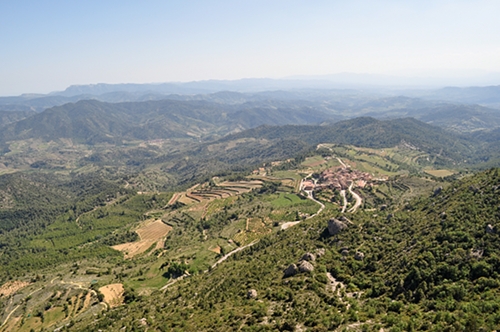
Scrubby vegetation and vineyards: it may look like California, but it’s not. Photo: Jennifer Skene.
I just got back from a month-long rock climbing trip near Barcelona, Spain—and though I’d never been there before, the vegetation looked a bit familiar. Hiking around, my skin was constantly scratched by the stiff, sharp leaves of shrubby plants—similar to California’s chaparral. Lizards I almost recognized darted across dry patches of dirt. The weather was similar to California’s, too—being summer, it was hot and dry. This was no coincidence. Spain, in the Mediterranean Basin, is California’s climate cousin.
On every continent except Antarctica, the west coasts share a similar climate, called the Mediterranean climate. It is characterized by warm to hot summers with basically no rainfall, and winters that are short, mild, and wet. A world map of Mediterranean climate regions shows that in addition to the Mediterranean Basin and the coast of California, the west coast of South America from Peru to Chile, the northwest part of Africa, parts of western and southern Australia, and parts of South Africa all share the Mediterranean climate. The sweet spot is at about 35 degrees latitude, both north and south.
Climate is a product of ocean currents and the up-and-down movement of air above Earth’s surface. In the northern hemisphere ocean currents swirl clockwise, and in the southern hemisphere ocean currents swirl counter-clockwise, thanks to Earth’s rotation and the resultant Coriolis Effect. The direction of the currents means that water flowing along the west coast of all continents is cold, having recently come from the poles. Air follows the ocean currents, binging storms and precipitation in winter. In summer, the effect of the up-and-down movement of air in the atmosphere kicks in and influences climate. In summer, dry air sinks along the latitude band of about 30 degrees to 35 degrees. The dry sinking air prevents storms from moving in, and is largely responsible for Mediterranean regions’ summer droughts. Sinking and rising of air on Earth’s surface is due to the Sun’s uneven heating of Earth.
Those scratchy shrubs that plagued me throughout my vacation are the signature flora of Mediterranean climates. Drought-tolerant evergreen shrubs exist in every Mediterranean region. In fact, the word to describe California’s scrappy shrubs, chaparral, has Spanish origins—chaparro (initially txapar in Basque) means dwarf evergreen oak. We now use the word chaparral to refer to the whole habitat type, not just the shrubs themselves. Elsewhere, this habitat type goes by other names. In the Mediterranean region, it is called maquis; in South Africa, it is the fynbos; and in Australia, it’s called kwongan.
